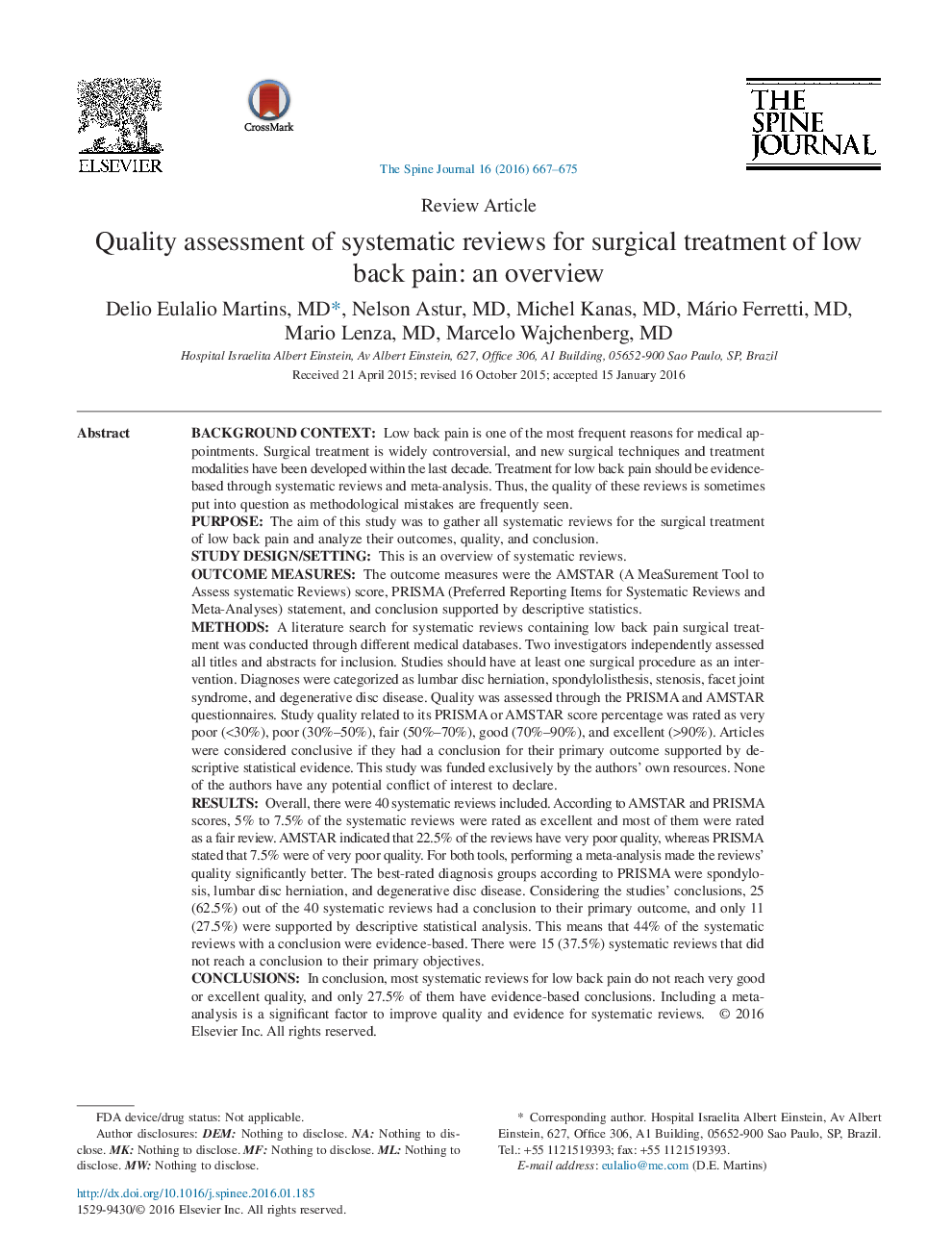| کد مقاله | کد نشریه | سال انتشار | مقاله انگلیسی | نسخه تمام متن |
|---|---|---|---|---|
| 4096124 | 1268552 | 2016 | 9 صفحه PDF | دانلود رایگان |
Background ContextLow back pain is one of the most frequent reasons for medical appointments. Surgical treatment is widely controversial, and new surgical techniques and treatment modalities have been developed within the last decade. Treatment for low back pain should be evidence-based through systematic reviews and meta-analysis. Thus, the quality of these reviews is sometimes put into question as methodological mistakes are frequently seen.PurposeThe aim of this study was to gather all systematic reviews for the surgical treatment of low back pain and analyze their outcomes, quality, and conclusion.Study Design/SettingThis is an overview of systematic reviews.Outcome MeasuresThe outcome measures were the AMSTAR (A MeaSurement Tool to Assess systematic Reviews) score, PRISMA (Preferred Reporting Items for Systematic Reviews and Meta-Analyses) statement, and conclusion supported by descriptive statistics.MethodsA literature search for systematic reviews containing low back pain surgical treatment was conducted through different medical databases. Two investigators independently assessed all titles and abstracts for inclusion. Studies should have at least one surgical procedure as an intervention. Diagnoses were categorized as lumbar disc herniation, spondylolisthesis, stenosis, facet joint syndrome, and degenerative disc disease. Quality was assessed through the PRISMA and AMSTAR questionnaires. Study quality related to its PRISMA or AMSTAR score percentage was rated as very poor (<30%), poor (30%–50%), fair (50%–70%), good (70%–90%), and excellent (>90%). Articles were considered conclusive if they had a conclusion for their primary outcome supported by descriptive statistical evidence. This study was funded exclusively by the authors' own resources. None of the authors have any potential conflict of interest to declare.ResultsOverall, there were 40 systematic reviews included. According to AMSTAR and PRISMA scores, 5% to 7.5% of the systematic reviews were rated as excellent and most of them were rated as a fair review. AMSTAR indicated that 22.5% of the reviews have very poor quality, whereas PRISMA stated that 7.5% were of very poor quality. For both tools, performing a meta-analysis made the reviews' quality significantly better. The best-rated diagnosis groups according to PRISMA were spondylosis, lumbar disc herniation, and degenerative disc disease. Considering the studies' conclusions, 25 (62.5%) out of the 40 systematic reviews had a conclusion to their primary outcome, and only 11 (27.5%) were supported by descriptive statistical analysis. This means that 44% of the systematic reviews with a conclusion were evidence-based. There were 15 (37.5%) systematic reviews that did not reach a conclusion to their primary objectives.ConclusionsIn conclusion, most systematic reviews for low back pain do not reach very good or excellent quality, and only 27.5% of them have evidence-based conclusions. Including a meta-analysis is a significant factor to improve quality and evidence for systematic reviews.
Journal: The Spine Journal - Volume 16, Issue 5, May 2016, Pages 667–675
